I am quite a rookie in the VHDL world, but I seem to have hold of the basics. Atm I am working on a project, which involves me to take a 4-bit binary input (switches), read this value and convert it to decimal values.
This far I have variables (count_ones, count_tens) which are supposed to contain the decimal value of the input.
My current code is as following:
architecture Behavioral of Seven_Seg_Counter is
signal count_ones : integer range 0 to 9 := 0;
signal count_tens : integer range 0 to 9 := 0;
signal count_hundreds : integer range 0 to 9 := 0;
signal count_thousands : integer range 0 to 9 := 0;
signal prescaler : integer := 0;
signal anode : integer range 1 to 4 := 1;
signal digit : STD_LOGIC_VECTOR(3 downto 0) := "1110";
begin
Calculate: process (CLK)
variable countings : integer range 0 to 9 := 0;
begin
if rising_edge(CLK) then
if INPUT(3) = '1' then
countings := 8;
else
countings := 0;
end if;
if INPUT(2) = '1' then
countings := countings + 4;
else
countings := 0;
end if;
if INPUT(1) = '1' then
countings := countings + 2;
else
countings := 0;
end if;
if INPUT(0) = '1' then
countings := countings + 1;
else
countings := 0;
end if;
for I in 1 to 9 loop
if countings > 9 then
countings := countings - 10;
count_tens <= count_tens + 1;
else
count_tens <= 0;
end if;
end loop;
for G in 1 to 9 loop
if countings > 0 then
countings := countings - 1;
count_ones <= count_ones + 1;
else
count_ones <= 0;
end if;
end loop;
end if;
end process;
process (anode, count_thousands, count_hundreds, count_tens, count_ones) -- Bestemmer output som funktion signalerne anode (segmentvælger) og count_XX (den decimale værdi)
begin
case anode is
when 1 =>
case count_ones is
--abcdefg
when 0 => sseg <= "0000001"; -- 0
when 1 => sseg <= "1001111"; -- 1
when 2 => sseg <= "0010010"; -- 2
when 3 => sseg <= "0000110"; -- 3
when 4 => sseg <= "1001100"; -- 4
when 5 => sseg <= "0100100"; -- 5
when 6 => sseg <= "0100000"; -- 6
when 7 => sseg <= "0001111"; -- 7
when 8 => sseg <= "0000000"; -- 8
when 9 => sseg <= "0000100"; -- 9
end case;
when 2 => case count_tens is
--abcdefg
when 0 => sseg <= "0000001"; -- 0
when 1 => sseg <= "1001111"; -- 1
when 2 => sseg <= "0010010"; -- 2
when 3 => sseg <= "0000110"; -- 3
when 4 => sseg <= "1001100"; -- 4
when 5 => sseg <= "0100100"; -- 5
when 6 => sseg <= "0100000"; -- 6
when 7 => sseg <= "0001111"; -- 7
when 8 => sseg <= "0000000"; -- 8
when 9 => sseg <= "0000100"; -- 9
end case;
when 3 => case count_hundreds is
--abcdefg
when 0 => sseg <= "0000001"; -- 0
when 1 => sseg <= "1001111"; -- 1
when 2 => sseg <= "0010010"; -- 2
when 3 => sseg <= "0000110"; -- 3
when 4 => sseg <= "1001100"; -- 4
when 5 => sseg <= "0100100"; -- 5
when 6 => sseg <= "0100000"; -- 6
when 7 => sseg <= "0001111"; -- 7
when 8 => sseg <= "0000000"; -- 8
when 9 => sseg <= "0000100"; -- 9
end case;
when 4 => case count_thousands is
--abcdefg
when 0 => sseg <= "0000001"; -- 0
when 1 => sseg <= "1001111"; -- 1
when 2 => sseg <= "0010010"; -- 2
when 3 => sseg <= "0000110"; -- 3
when 4 => sseg <= "1001100"; -- 4
when 5 => sseg <= "0100100"; -- 5
when 6 => sseg <= "0100000"; -- 6
when 7 => sseg <= "0001111"; -- 7
when 8 => sseg <= "0000000"; -- 8
when 9 => sseg <= "0000100"; -- 9
end case;
end case;
end process;
process (anode)
begin
case anode is
when 1 => digit <= "1110";
when 2 => digit <= "1101";
when 3 => digit <= "1011";
when 4 => digit <= "0111";
end case;
end process;
segmentselect <= digit;
LED_OUT <= INPUT;
end Behavioral;
My idea is, I store the binary value (looking aside 1's and 2's complement) in the variable countings (which works fine in a simulation). The next part is, where I actually find the value of countings, and store it's rightmost digit in the signal count_ones (ones), and the leftmost digit (tens) in the signal count_tens. For some unknown reason, my way of finding the ones and tens does not work well with those loops. Maybe I totally misunderstood how to use for loops.
Could any of you maybe help me out? I would really appreciate it.
Loops are tricky indeed. The thing is, a 4-bit input is only the beginning, I'd like to be able to read more, so if I can learn the basic method with just 4 bits, that'd be awesome.
Well, the count_ones signal is for the ones, and the count_tens is for the tens of the input, so I am not quite sure I get, how to_integer(unsigned(INPUT)); is gonna work out, so I get a decimal value from 0 to 9 in count_ones or count_tens.
The subtraction method you are referencing to, I believe, I have tried to implement that in my loops, which do not work out as expected.
